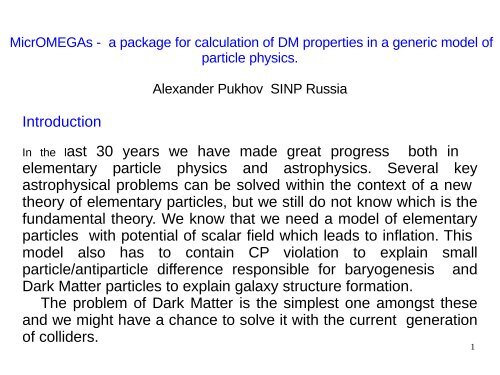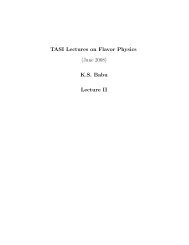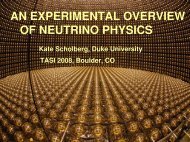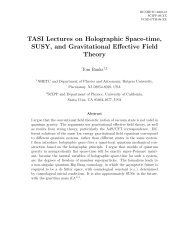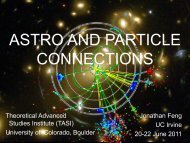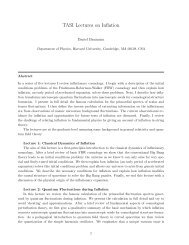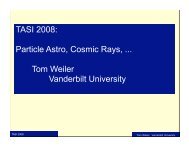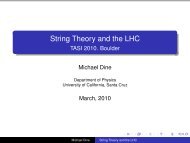Introduction In the last 30 years we have made great progress both ...
Introduction In the last 30 years we have made great progress both ...
Introduction In the last 30 years we have made great progress both ...
- No tags were found...
You also want an ePaper? Increase the reach of your titles
YUMPU automatically turns print PDFs into web optimized ePapers that Google loves.
MicrOMEGAs - a package for calculation of DM properties in a generic model ofparticle physics.<strong><strong>In</strong>troduction</strong>Alexander Pukhov SINP Russia<strong>In</strong> <strong>the</strong> <strong>last</strong> <strong>30</strong> <strong>years</strong> <strong>we</strong> <strong>have</strong> <strong>made</strong> <strong>great</strong> <strong>progress</strong> <strong>both</strong> inelementary particle physics and astrophysics. Several keyastrophysical problems can be solved within <strong>the</strong> context of a new<strong>the</strong>ory of elementary particles, but <strong>we</strong> still do not know which is <strong>the</strong>fundamental <strong>the</strong>ory. We know that <strong>we</strong> need a model of elementaryparticles with potential of scalar field which leads to inflation. Thismodel also has to contain CP violation to explain smallparticle/antiparticle difference responsible for baryogenesis andDark Matter particles to explain galaxy structure formation.The problem of Dark Matter is <strong>the</strong> simplest one amongst <strong>the</strong>seand <strong>we</strong> might <strong>have</strong> a chance to solve it with <strong>the</strong> current generationof colliders.1
MicrOMEGAs is a package for calculation of different observablesrelated to Dark Matter. It was created in French-Russancollaboration by G.Belanger, F.Boudjema (LAPTH),A.Semenov (JINR), A. Pukhov (SINP)The main features of micrOMEGAs is calculation of DM properties inframework of generic model of particle interaction.2
Massive Stable ParticleTo describe DM first of all <strong>we</strong> need a model with a stable massiveparticle (WIMP?). For this <strong>we</strong> need, for example, a Z 2 symmetrywhich divides all particles into two classes, odd and even. If <strong>the</strong>parity is conserved, <strong>the</strong>n <strong>the</strong> lightest odd particle is stable. <strong>In</strong>many models such symmetry appears quite natural. Forinstance, in SUSY models SM particles are even under R-paritywhile <strong>the</strong>ir superpartners are odd. <strong>In</strong> models with one extradimension x 5-> -x 5symmetry leads to corresponding Z 2 .Models with Z n symmetry also <strong>have</strong> a stable particle. For n>3several stable particles can appear. Practically <strong>we</strong> meet Z 2 andZ 3 cases.3
Simple exampl. <strong>In</strong>ert Doublet Model<strong>In</strong>ert Doublet model contains two SU(2)*U(1) doubletsThe Lagrangian contains only even po<strong>we</strong>rs of H 2 doubletBecause of symmetry one of new particlesIs stable . Parameterscan be expressed in terms of massesNew couplings areSee details arXiv:1106.17194
<strong>In</strong> <strong>the</strong> framework of a given model of elementary particles <strong>we</strong>calculate different observables related to DM:A) Density of DM particles.Global DM density is known from measurements of CMB temperaturefluctuations.Ω dm= ρ dm /ρ cr = 0.105(8) /h 2where h =0.73(3) is present day Hubble rateH=h*100km/s/Mpcρ rc =10.537h^2 GeV/m 3 , so ρ dm = 1.11 GeV/m 3First of all our model of elementary particles has to reproduce thisnumber.5
The measured galactic rotation curves v(R) ( R is distance fromgalactic center) allows to estimate DM distribution in our galaxy<strong>In</strong> particular DM density at Sun orbit is estimated asρ Sun = 0.1-0.7 GeV/cm 3B) The annihilation of DM particles into standard model particles in<strong>the</strong> galactic halo leads to secondary particles ( photons, positrons,antiprotons ) which can be detected on satellite ( Pamela, AMS,Fermi ) and ground experiments (Hess). It is called indirect DMdetection.C) DM can interact with matter, <strong>the</strong> energy distribution of recoilnuclei can be measured in large scale underground detectors(DAMA, COUPP, CDMS, Xenon experiments). They are calleddirect detection experiments. Direct detection signal depends on<strong>the</strong> velocity distribution of DM particles. DM velocities are is closeto <strong>the</strong> Sun orbital velocity, 220 km/s6
C) Solar neutrinos. <strong>In</strong> some sense <strong>the</strong> Sun works like a large scaledetector in direct detection experiment. The number of DMparticles captured by <strong>the</strong> Sun in result of collisions determines <strong>the</strong>number of DM annihilations in <strong>the</strong> center of Sun. Suchannihilations in turn produce high energy neutrinos which can bedetected in neutrino observatories like Super-Kamiokande and IceCube.D) <strong>In</strong> collider experiments <strong>we</strong> expect to produce mostly coloredodd particles . These particles decay eventually to invisible DMparticles. Such events can be detected via missing transverseenergy.The micrOMEGAs package enables to calculate : Ω dm,fluxes of photons, antiprotons, and positrons for indirectDM searches; cross sections of DM interactions withnuclei and energy distribution of recoiled nuclei; neutrinoflux from DM particles captured by <strong>the</strong> Sun; collider crosssections.7
MicrOMEGAs uses CalcHEP to generate codes for matrixelements. It makes micrOMEGAs flexible for new modelimplementation.MicrOMEGAs is written in C but user program can be writtenin C, C++, FORTRANPlatforms are Linux, MacO<strong>the</strong>r code for DM business:DarkSUSY: http://www.physto.se/~edsjo/darksusySuperISO : http://superiso.in2p3.frIsaJet : http://www.nhn.ou.edu/~isajetThere is a good agreement bet<strong>we</strong>en <strong>the</strong>se codes.8
To Downloadhttp://lapth.in2p3.fr/micromegasThe name of file should bemicromegas_2.4.X.tgzUnpack it bytar -xvzf micromegas_2.4.X.tgzIt should create directory micromegas_2.4.X/ which occupies about 40Mb of disk space. You will need more disk space after compilation of specificmodels and generation of matrix elements .<strong>In</strong> case of problems and questionsemail: micro.omegas@lapp.in2p3.frFor current lecture downloadhttp://<strong>the</strong>ory.sinp.msu.ru/~pukhov/micromegas_2.2.tgz9
File structure of micrOMEGAs package.Makefilemanual24.texdescription of micrOMEGAs routinesCalcHEP_src/ generator of matrx elements for micrOMEGAssources/micrOMEGAs codemodel directories:MSSM/Makefilemain.c main.F file with main program to call o<strong>the</strong>r oneslib/directory for routines specific to this modelMakefile....... source codeswork/CalcHEP working directory for matrix element generationMakefilework_aux.a information about particles and parameters extracted frommodel filesmodels/ model specificationvars1.mdl func1.mdl prtcls1.mdl lgrng1.mdl extlib1.mdltmp/results/so_generated/ directory to store generated matrix elementscalchep/for interactive CalcHEP sessionsNMSSM/CPVMSSM/IDM/LHM/RHNM/etc/Next-to-Minimal Susy ModelMSSM with complex parameters<strong>In</strong>ert doublet modelLittle Higgs ModelRight-handed Neutrino modelfor testing10
Compilation of CalcHEP and micromegas routines.CalcHEP and micrOMEGAs are compiled by gmake. Go to micromegas directoryand launchgmakeIf gmake is absent, <strong>the</strong>n make should work like gmake.micrOMEGAs should define automatically names of C and Fortran compilers and flagsof compilation. <strong>In</strong> case of problem open file with compiler options generated bymicrOMEGAs CalcHEP_src/FlagsForSh and try to improve it and launch [g]makeagain. The file looks like# C compilerCC="gcc"# Flags for C compilerCFLAGS="-g -fsigned-char"# Disposition of header files for X11HX11=# Disposition of lX11LX11="-lX11"# Fortran compilerFC="gfortran"FFLAGS="-fno-automatic"........[g]make clean deletes all generated files, but asks permission to delete FlagsForSh[g]make flags only generates FlagsForShIf micrOMEGAs has success in definition of compilers and <strong>the</strong>ir flags it rewritesFlagsForSh into FlagsForMake which is substituted in all Makefiles of micrOMEGAspackage.11
Possible problem:X11If X11 is not completely installed on your computerCalcHEP and micrOMEGAs are compiled in 'blind' version.For micrOMEGAs it is not crucial, you only will lost an option toDisplay micrOMEGAs plots.Check /usr/include/X11.If it is empty, install X11 development package:libX11-devellibX11-devxorg-x11-develFedora/Scientific Linux/CYGWIN/Darwin(MAC)Ubuntu/DebianSUSE12
Module structure of main programs.main.c, main.F files in micrOMEGAs model directories consist ofseveral blocks enclosed into#ifdef XXXXX....................#endifUser can switch on/off any of <strong>the</strong>se blocks by corresponding #defineinstruction:#define MASSES_INFO /* Display information about mass spectrum */#define CONSTRAINTS /* Display B_>sgamma, Bs->mumu, ...*/#define OMEGA /* Calculate relic density */#define INDIRECT_DETECTION /* Signals of DM annihilation in galactic halo *///#define RESET_FORMFACTORS /* Redefinition of Form Factors and o<strong>the</strong>r parameters */#define CDM_NUCLEON/* Calculate amplitudes and cross-sections for CDMnucleoncollisions *///#define CDM_NUCLEUS/* Calculate number of events for 1kg*day and recoilenergy distribution for various nuclei */13
Compilation and launching of executable for specific models.After compilation of CalcHEP and micrOMEGAs one has to compile<strong>the</strong> executable to produce DM related observables in specific model. Todo this go to model directory and launch[g]make main=main.cIt should generate executable main. <strong>In</strong> <strong>the</strong> same mannergmake main=filename.extgenerates executable filename based on <strong>the</strong> source file filename.extFor ext <strong>we</strong> <strong>have</strong> 3 options 'c' , 'F', 'cpp' which corresponds toC, FORTRAN and C++ sources.[g]make in model directory automatically compilesmodel/lib/aLib.a library needed for model realizationmodel/work/work_aux.a library which contains information aboutparticles and parameters14
Parameters of main programs.Default versions of main.c/F programs need some argumentswhich <strong>have</strong> to be passed in command lines. If launched withoutarguments <strong>the</strong>y explain which parameter are needed. For instancein MSSM./mainThis program needs 4 parameters:m0 common scalar mass at GUT scalemhf common gaugino mass at GUT scalea0 trilinear soft breaking parameter at GUT scaletb tan(beta)Auxiliary parameters are:sgn +/-1, sign of Higgsino mass term (default 1)Mtp top quark pole massMbMb Mb(Mb) scale independent b-quark massalfSMZ strong coupling at MZExample: ./main 120 500 -350 10 1 173.1Often micromegas needs at launching <strong>the</strong> name of file withnumerical values of model parameters. The structure of <strong>the</strong> filerecord should beName Value # comment ( optional)For instanceMG1 200.MG2 400.15
Example of micrOMEGAs session. MSSM, SUGRA scenario../main 120 500 -350 10 1 173.1M0 M 1/2 A0 tgb sign(mu) Mtop========= mSUGRA scenario =====Spectrum calculator is suspectWarnings from spectrum calculator:.....noneDark matter candidate is '~o1' with spin=1/2 mass=2.06E+02~o1 = 0.997*bino 0.015*wino +0.074*higgsino1 0.029*higgsino2=== MASSES OF HIGGS AND SUSY PARTICLES: ===Higgs masses and widthsh 115.99 3.07E03H 766.59 1.65E+00H3 766.34 1.68E+00H+ 770.85 1.61E+00Masses of odd sector Particles:~o1 : MNE1 = 205.9 || ~l1 : MSl1 = 212.3 || ~eR : MSeR = 223.7~mR : MSmR = 223.7 || ~nl : MSnl = 344.8 || ~ne : MSne = 346.8~nm : MSnm = 346.8 || ~eL : MSeL = 355.4 || ~mL : MSmL = 355.4~l2 : MSl2 = 356.5 || ~1+ : MC1 = 389.6 || ~o2 : MNE2 = 389.7~o3 : MNE3 = 692.7 || ~2+ : MC2 = 704.2 || ~o4 : MNE4 = 704.3~t1 : MSt1 = 767.9 || ~b1 : MSb1 = 959.3 || ~b2 : MSb2 = 1005.7~t2 : MSt2 = 1006.1 || ~dR : MSdR = 1009.9 || ~sR : MSsR = 1009.9~uR : MSuR = 1013.4 || ~cR : MScR = 1013.4 || ~uL : MSuL = 1050.2~cL : MScL = 1050.2 || ~dL : MSdL = 1053.1 || ~sL : MSsL = 1053.1~g : MSG = 1146.4 ||16
==== Physical Constraints: =====deltartho=1.51E05gmuon=9.47E10bsgnlo=3.22E04bsmumu=3.09E09btaunu=9.91E01MassLimits OK==== Calculation of relic density =====Xf=2.65e+01 Omega=1.10e01Channels which contribute to 1/(omega) more than 1%.Relative contrubutions in % are displyed29% ~o1 ~l1 >A l21% ~l1 ~l1 >l l8% ~o1 ~l1 >Z l6% ~l1 ~L1 >A A4% ~o1 ~o1 >l L3% ~o1 ~o1 >m M3% ~o1 ~o1 >e E3% ~o1 ~eR >A e3% ~o1 ~mR >A m3% ~l1 ~L1 >A Z3% ~eR ~l1 >e l3% ~mR ~l1 >m l17
==== <strong>In</strong>direct detection =======Channelvcs[cm^3/s]~o1,~o1 > b B 2.25E29~o1,~o1 > t T 2.55E29~o1,~o1 > l L 5.37E29~o1,~o1 > W+ W 2.95E31~o1,~o1 > l L 5.37E29~o1,~o1 > t T 2.55E29~o1,~o1 > b B 2.25E29~o1,~o1 > W+ W 2.95E31sigmav=1.02E28[cm^3/s]Photon flux for angle of sight f=0.00[rad]and spherical region described by cone with angle 0.0349[rad]Photon flux = 7.53E16[cm^2 s GeV]^{1} for E=103.0[GeV]Positron flux = 3.50E14[cm^2 sr s GeV]^{1} for E=103.0[GeV]Antiproton flux = 1.99E15[cm^2 sr s GeV]^{1} for E=103.0[GeV]==== Calculation of CDMnucleons amplitudes =====CDMnucleon micrOMEGAs amplitudes:proton: SI 1.316E09 SD 1.575E08neutron: SI 1.333E09 SD 1.984E08CDMnucleon cross sections[pb]:proton SI 7.502E10 SD 3.223E07neutron SI 7.696E10 SD 5.113E0718
Free parameters of <strong>the</strong> model.Free model parameters are presented in MODEL/work/models/vars1.mdlFor example:<strong>In</strong>ert Doublet ModelVariablesName | Value |> Comment
<strong>In</strong> order to download set of parameters micrOMEGAs has <strong>the</strong> functionreadVar(fileName)which returns zero in case of successful reading. Structure of file records hasto bename value [ # comment ]For instance, in case of IDMAL 0.01 # couplingMHX 65 # inert sector HiggsMh 150 # SM Higgs massLa2 0.01 # couplingMHC 115 # mass of charged HiggsMH3 115 # mass of CP odd HiggsWhen micrOMEGAs requires to write in a command line name of file , <strong>the</strong>file should <strong>have</strong> this format.20
Constrained parameter of <strong>the</strong> model.Constrained parameters are stored in file MODEL/work/models/func1.mdlFor example<strong>In</strong>ert DoubletConstraintsName |> ExpressionCW |sqrt(1-SW^2)MW |MZ*CWMb |MbEff(Q)Mc |McEff(Q)mu2 |MHX^2-laL*(2*MW/EE*SW)^2la3 |2*(MHC^2-mu2)/(2*MW/EE*SW)^2la5 |(MHX^2-MH3^2)/(2*MW/EE*SW)^2%Local!|The upper part of list of constrained parameters are public parameters whosevalues can be obtained by findValW(name). O<strong>the</strong>r constraints appears only insidematrix elements and can not be accessed by <strong>the</strong> user. All parameters involved in <strong>the</strong>calculation of particle masses are public as <strong>we</strong>ll as all parameters which call externalfunctions for calculations. All parameters disposed above marker “%Local!” arepublic too.21
Particles of <strong>the</strong> modelList fo particles presented in file MODEL/work/models/prtcls1.mdlFull Name | P | aP| number |spin2|mass|width|color|aux|> LaTeX(A)photon |A |A |22 |2 |0 |0 |1 |G |AZ boson |Z |Z |23 |2 |MZ |wZ |1 |G |Zgluon |G |G |21 |2 |0 |0 |8 |G |GW boson |W+ |W- |24 |2 |MW |wW |1 |G |W^+neutrino |n1 |N1 |12 |1 |0 |0 |1 |L |\nu^eelectron |e1 |E1 |11 |1 |0 |0 |1 | |emu-neutrino |n2 |N2 |14 |1 |0 |0 |1 |L |\nu^\mumuon |e2 |E2 |13 |1 |Mm |0 |1 | |\mutau-neutrino |n3 |N3 |16 |1 |0 |0 |1 |L |\nu^\tautau-lepton |e3 |E3 |15 |1 |Mt |0 |1 | |\tauu-quark |u |U |2 |1 |0 |0 |3 | |ud-quark |d |D |1 |1 |0 |0 |3 | |dc-quark |c |C |4 |1 |Mc |0 |3 | |cs-quark |s |S |3 |1 |Ms |0 |3 | |st-quark |t |T |6 |1 |Mtop|wtop |3 | |tb-quark |b |B |5 |1 |Mb |0 |3 | |bHiggs |h |h |25 |0 |Mh |!wh |1 | |hodd Higgs |~H3|~H3|36 |0 |MH3 |!wH3 |1 | |(H3)Charged Higgs |~H+|~H-|37 |0 |MHC |!wHC |1 | |(H+)second Higgs |~X |~X |35 |0 |MHX |!wHX |1 | |(X)Names of particles of odd sector are started with tilde ~22
err = sortOddParticles( stext)This function has to be call before o<strong>the</strong>r ones when starting to work with amodel or when changing <strong>the</strong> values of some model parameters.This function calculates all public constraints. <strong>In</strong> case of success err=0 andtext parameter contains name of lightest odd particles. If some ofconstrained parameter can not be calculated <strong>the</strong>n err!=0 and name of whichparameter is written in text.err = qNumbers(pName, &spin2,&charge3,&cdim)returns quantum number of particle pName . <strong>In</strong> particular you can checkthat your Dark Matter candidate has no electric or color charges.Mcdm - global parameter for mass of DM particle.For any particle one can get its mass via particle name byMass= pMass(pName)23
Generation of matrix elements by CalcHEP.Calchep can work in blind regimes_calchep blind "key sequence"Special symbols: {Enter, }Esc, [down arrow key, ] up arrow{ {Dark Matter Model => Enter Process =>Standard ModelForce Unit.Gauge OFF.............. Edit ModelIMPORT OF MODELS Numerical EvaluationEnter process: ~dm,~dm > 2*x { View diagrams [{Exclude diagram with { Squaring techniqueExclude Xparticles:~dm { => Write down processesView squared diagram [{ Ccode { Quit (F10) 0Symbolic calculation => CcompilerMake&Launch n_calchep Edit linkerMake n_calchepREDUCE codeSo, <strong>the</strong> command to generate processes of DM annihilation isrm tmp/*bin/s_calchep blind “{{~dm,~dm>2*x{{~dm{[{[{{0”24
Shared libraries of matrix elementsmicrOMEGAs transfers C-code of matrix elements into shared librarygcc -shared -o library_name.so matrix_element_files.cAll shared libraries of matrix elements for given MODEL are stored inMODEL/work/so_generated/directory. They are recompiled automatically if <strong>the</strong> model in changed.Shared library can be linked dynamicaly in runtime. See man for dlopen,dlsym.* =========== file dltest.c =========*/#include #include int main(void){ void *handle; double (*arcsin)(double);handle = dlopen("/usr/lib/libm.so",RTLD_NOW);arcsin = dlsym(handle,"asin");printf ("%f\n", 2*(*arcsin)(1));}║$ gcc dltest.c -o dltest -rdynamic -ldl║$ ./dltest║ 3.14159325
Calculation of cross sections and in micrOMEGAsnumout *cc ;// numout – is a type for matrix element in micrOMEGAs.cc = newProcess(char*Process); // call CalcHEP to calculate symbolicallyand compile matrix element for given process. For instancecc = newProcess(“e,E->m,M”);Then cross sections of 2->2 processes can be calculated bycs= cs22(cc,L,Pcm,cos_min,cos_max,&err);Pcm – momentum in Center of Mass reference framecos_min, cos_max - cuts for cosine of scattering angle in <strong>the</strong> same frameL=1 in case you <strong>have</strong> generated codes only for one process. For general caseL numerates subprocesses.hCollider( Pcm, pp, pName1, pName2) calculates cross section ofproduction of two heavy particle on hadron collider. If pp>0 <strong>the</strong>n protonprotoncase collision is considered, o<strong>the</strong>rwise p proton-antiproton one. ForexamplehCollider(35000.,1 , “~u1”,”~U1” ) calculates cross section in [pb] of squarkproduction at LHC.26
Calculation of particle widths in micrOMEGAstxtList L;double width = pWidth( pName, &L);printTxtList(L,stdout);Br= findBr(txtList L, pattern);// variable for decay channels// calculation widths and// branching// display decay channels// find branchingIf two particle decays are kinematically forbidden, micrOMEGASautomatically calculates 3-body decays.EXAMPLECODEwidth=pWidth(“l”,&L); // tau leptonprintf(“tau total width=%E \n ”, width);printf( “Branchings:\n");printTxtList(L,stdout);printf("Br(e,Ne,nl)= %E\n",findBr(L,"e,Ne,nl"));OUTPUTtau total width=2.052624E-12Branchings:5.998536E-01 l -> nl,U,d2.000733E-01 l -> m,Nm,nl2.000733E-01 l -> e,Ne,nlBr(e,Ne,nl)= 2.000733E-0127
Calculation of Relic Densityomega= darkOmega(&Xf, fast); // calculates Ω dm h 2fast = 1 – optimized fast calculation ; 0 – robust calculation.Xf = Mcdm/Tf - return parameter. Tf is freeze-out temperaturedefined by conditionρ dm (T f ) = 2.5 ρ dm_equilibrium (T f )28
Coannihilation and Beps parameterAs a rule <strong>we</strong> <strong>have</strong> several particles in odd sector. We assumethat all of <strong>the</strong>m are in chemical equilibriumNi / Nj = exp ( -( mi – mj )/T)All reactions like ~i,~j -> SM are responsible for DM formation.This is a reason <strong>we</strong> need a lot of matrix elements to to calculatecoannihilation channels. But density of heavy odd particles issuppressed my Boltzmann factor an can be omitted.We <strong>have</strong> Beps parameter which cuts calculation of suppressedcoannihilation channels:~i, ~j -> SMIs omitted ifExp( -(mi + mj – 2*Mcdm)/T) < BepsDefault value Beps = 1.E-3.29
Thermal equation for Dark Matter.<strong>30</strong>
We define abundance Y=N/s to remove H*N termTime evolution can be transformed into <strong>the</strong>rmal oneForNumerical estimationsUntil Yeq(T)* γ (T) >>1 <strong>we</strong> <strong>have</strong> chemical equilibrium Y(T)==Y eq (T)31
When Yeq(T)γ(T) ~ 1 , Y does not follow to Yeq, <strong>we</strong> <strong>have</strong> soonYeq
Ω = M cdm [GeV] * Y * (2.889 10 9 m -3 entropy today)/ (10.57 h 2 GeV m -3 critical dencity)33
micrOMEGAs tools for relic density calculation.All functions mentioned above are available for micrOMEGAs user. They aregeffSM(T), heffSM(T), YeqOdd(T), vSigma(T, fast)vSigma returns cross section in [pb] units. The user can display plot forany one parameter function by <strong>the</strong> commanddispayFunc( fName, x1, x2, Comment);For example:displayFunc(geffSM 0.001,10,”geff(T)”);displayFunc(YeqOdd,5,100,”Yeq(T)”);double vSigma1(double T){ return vSigma(T,1);} // write sepatatellydisplayFunc(vSigma1,1,20,”vSigma(T)”);34
vSigma[pb] & Yeqfor MSUGRA modelM0 = 120M1/2 = 500A0 = -350Tb= 10sign(mu)= 136
EXERCISEUsing micrOMEGAs tools write your own program for calculation Ωh 21) Caution : vSigma returns value in pb. 1pb=1/3.8937966E8GeV^22) To solve differential equation write a function which calculates derivativevoid derive( double logS, double *Y, double * dYdlogS){ .... * dYdlogS=... }And use odeint(&Y, 1 , logS_start, logS_fin, Eps, H, derive);to solve equation by Runge-Kutta methodEps – precisionH – initial stepY =Yeq at start and contains observed Y after integration.3) Caution: Step of integration will be about 1/γ(T) . Do not start from veryhigh temperature!4) write in <strong>the</strong> top of your file#include"../sources/micromegas.h"#include"../sources/micromegas_aux.h"37


